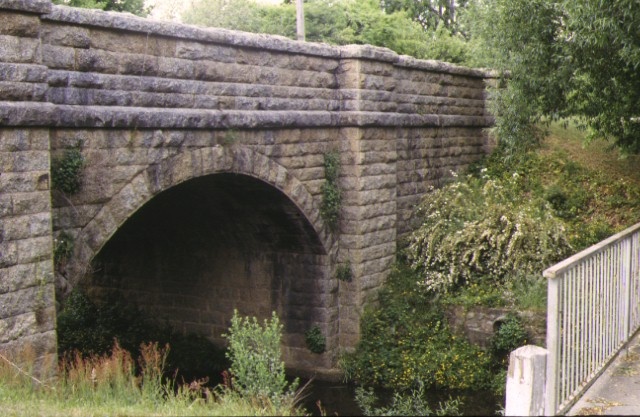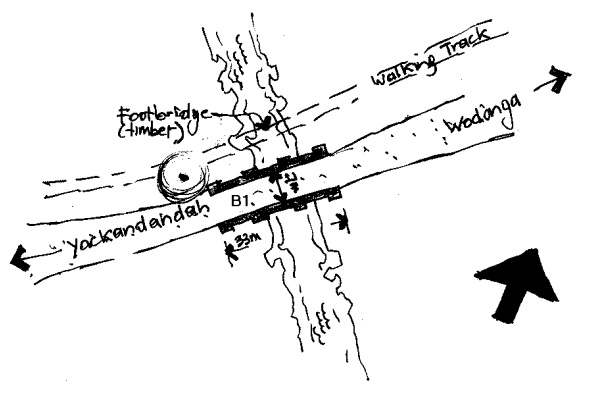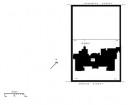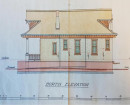BRIDGE
OVER COMMISSIONERS CREEK, ISAACS AVENUE YACKANDANDAH, INDIGO SHIRE
-
Add to tour
You must log in to do that.
-
Share
-
Shortlist place
You must log in to do that.
- Download report




Statement of Significance
What is significant?
The Bridge over Commissioner's Creek is a single arched bridge which was constructed c. 1857. The entire bridge is constructed of rusticated granite dimension stones. The capping stones are darker than the majority of the stones used in the parapet walls and the arches are distinctively oval shaped. The bridge marks the southern entrance to the township of Yackandandah.
How is it significant?
The Bridge over Commissioner's Creek is of architectural and historical importance to the State of Victoria.
Why is it significant?
The Bridge over Commissioner's Creek is of architectural importance as an intact example of an early Victorian bridge. The structure is typical of a vernacular engineering tradition but is distinguished by its rusticated string course, rusticated parapet cappings, voussoirs and the elegant span of the single arch. The bridge is a superb example of Scottish stonemasonry and is further enhanced by the use of distinctive local granite. Like basalt, granite occurs naturally in the south west region of Victoria but the granite was more expensive to quarry and more difficult to work with. This being so, the splendid form of the bridge remains as a testimony to the skills of its creator. The structure marks the southern entrance into Yackandandah and enhances the general character of the town. The bridge has not been altered and remains in its original state.
The Bridge over Commissioner's Creek is of historical significance for its association with Victoria's gold mining history and the subsequent development of Yackandandah (one of Victoria's significant historic townships. Yackandandah experienced a rapid increase in population after the discovery of gold in the 1850s and this resulted in a need to improve transport infrastructure. The bridge assists in illustrating the growth of the Yackandandah township and provides a greater understanding of the development and impact of 19th century gold mining activities in the State. Investment in roads and railways helped establish the national transport system and bridges formed important links in this expanding network. The Bridge over Commissioner's Creek is historically significant for its role in the development of these systems.
-
-
BRIDGE - History
Contextual History:History of Place:
The need for infrastructure in a rapidly expanding settlement necessitated the construction of Australia's first roads shortly after the arrival of the first settlers. A first roadmap for Victoria dates from 1837. In 1838, the New South Wales Government authorised a survey of a road from Sydney to Melbourne and a contract was let for a fortnightly mail journey between the two centres.
This route passed through Kilmore to Seymour and then along the present Hume Highway to Albury.
Due to the gold rushes of the 1850's there was rapid growth in economic activity in Australia. Investment in roads and railways helped establish the national transport system and bridges formed important links in this expanding network.
The earliest Victorian bridges are not easy to trace, as they were apparently minor (often timber) structures on rural or makeshift roads.
Many bridges were opened at the time of the major railways in the 1860's and the expanding roadworks around Melbourne.
The lack of good freestone (sandstone) in Victoria, the only durable rocks for construction purposes during the early days of the colony, were basalt and granite. Traditionally, sandstone was preferred by stonemasons for ease of working and construction. Many considered sandstone a more attractive building material than the dark and less workable basalt.
Basalt occurs in and about Melbourne and throughout South Western Victoria as a typical stone construction material. Granite also occurs in these areas but it was more expensive to quarry and to work with.
There are no basalt outcrops in the North Eastern part of Victoria. As a result, the obvious choice for construction was granite. Central and North Eastern Victoria contains extensive areas of granite. The materials was extensively used in the construction of buildings (Beechworth Goal), churches and bridges.
There are several other examples of masonry (mostly granite bridges) in the area. Newtown Bridge in Beechworth, the bridge over the south-bound lane of the Hume Highway at Longwood, etc.
The present bridge at Bulla over Deep Creek (higher section of the Maribyrnong River) has four 8.2 spans and dates from around 1869. The bluestone bridge at Sunbury has two 13.4 meter arch spans and dates from 1870.
History of Place:
Yackandandah is located near Beechworth which is possibly Victoria's most notable historic town.
Although smaller, Yackandandah also owes its expansion to the gold rushes. The area was settled in 1837 mainly for the purpose of sheep grazing.
David Reid, one of the first and most foremost settlers of the north-east of Victoria established a water mill nearby. The town owes its important buildings and structures to the economic fortunes of the gold rushes. Yackandandah is a hill town and its setting is very picturesque and intimate. The township provides an excellent example of a nineteenth century mining township which has since the further developed in a small regional centre..
The roads are windy and the main thoroughfare is lined with impressive trees. Apart from the bridge over Commissioner's Creek there are a number of outstanding public buildings.
The bridge is a fine example of stonemason's skills. It was built in 1857 for 3500 pounds. It has been suggested that the structure may have been built with convicts' labour but this is probably incorrect because Victoria was never a penal colony.
Isaacs' Avenue was formerly known as Sydney Road. The road to Sydney ran through Beechworth and Yackandandah in the 1860's. The road to Sydney was re-routed through Chiltern from circa 1870.
COMPARISON:
The Bridge over Commissioner's Creek is essentially a typical Victorian Stone bridge. There are several examples of similar masonry (granite) bridges in regional Victoria. Although some of them have been altered to cater for the rise of motor vehicular traffic, most of them are in good condition. There is variety in shape, size and character.
Compared to other granite bridges, the bridge over Commissioner's Creek is rather small.
Bridge over Pranjip creek, Longwood
The bridge over Pranjip Creek was built from local granite presumably by Scottish masons. The skills required to work the decorative piers and crown stones would suppose the use of experienced stonemasons. The bridge is much smaller than the bridge over Spring Creek.
The bridge over Pranjip Creek was widened in 1957, resulting in a loss of structural integrity and some signs of instability.
Newtown Bridge, Beechworth
Newtown Bridge over Spring Creek at Beechworth is much larger in and slightly more complex in its detailing . In contrast with bridge over Pranjip Creek, Newtown Bridge remains unaltered today. In addition, this bridge has a stronger identity than the bridge over Pranjip Creek as it can be directly associated with local identities and the evolution of the goldmining industry in the historic township of Beechworth.
Bot the Newtown Bridge and the bridge over Commissioner’s' Creek derive their cultural significance from their location. Newtown bridge in many ways is situated in a more complex and but equally significant historic site.
Other bridges such as the Newlands Road Bridge in Coburg has three 9.1 meter spans and was built by prisoners from the Pentridge Goal. At Waurn Ponds, a small stone bridge carries a crest and the inscription "Barrabool Shire. 1868".BRIDGE - Permit Exemptions
General Exemptions:General exemptions apply to all places and objects included in the Victorian Heritage Register (VHR). General exemptions have been designed to allow everyday activities, maintenance and changes to your property, which don’t harm its cultural heritage significance, to proceed without the need to obtain approvals under the Heritage Act 2017.Places of worship: In some circumstances, you can alter a place of worship to accommodate religious practices without a permit, but you must notify the Executive Director of Heritage Victoria before you start the works or activities at least 20 business days before the works or activities are to commence.Subdivision/consolidation: Permit exemptions exist for some subdivisions and consolidations. If the subdivision or consolidation is in accordance with a planning permit granted under Part 4 of the Planning and Environment Act 1987 and the application for the planning permit was referred to the Executive Director of Heritage Victoria as a determining referral authority, a permit is not required.Specific exemptions may also apply to your registered place or object. If applicable, these are listed below. Specific exemptions are tailored to the conservation and management needs of an individual registered place or object and set out works and activities that are exempt from the requirements of a permit. Specific exemptions prevail if they conflict with general exemptions. Find out more about heritage permit exemptions here.Specific Exemptions:EXEMPTIONS FROM PERMITS:
(Classes of works or activities which may be undertaken without a permit under
Part 4 of the Heritage Act 1995)
General Conditions:
All alterations are to be planned and carried out in a manner which prevents
damage to the fabric of the registered place or object.
Should it become apparent during further inspection or the carrying out of
alterations that original or previously hidden or inaccessible details of the
place or object are revealed which relate to the significance of the place or
object, then the exemption covering such alteration shall cease and the
Executive Director shall be notified as soon as possible.
If there is a conservation policy and plan approved by the Executive Director,
all works shall be in accordance with it.
Nothing in this declaration prevents the Executive Director from amending or
rescinding all or any of the permit exemptions.
Nothing in this declaration exempts owners or their agents from the
responsibility to seek relevant planning or building permits from the
responsible authority where applicable.
No permit required for routine maintenance of the Bridge over Commissioner's
Creek.
No permit required to replace like with like on the Bridge over Commissioner's
Creek.
-
-
-
-
-
SG DEANS GROCERY AND HARDWARE STORE
 Victorian Heritage Register H0368
Victorian Heritage Register H0368 -
YACKANDANDAH COURT HOUSE
 Victorian Heritage Register H1490
Victorian Heritage Register H1490 -
YACKANDANDAH POLICE COMMISSIONERS CAMP
 Victorian Heritage Inventory
Victorian Heritage Inventory
-
'Altona' Homestead (Formerly 'Laverton' Homestead) and Logan Reserve
 Hobsons Bay City
Hobsons Bay City
-
-











